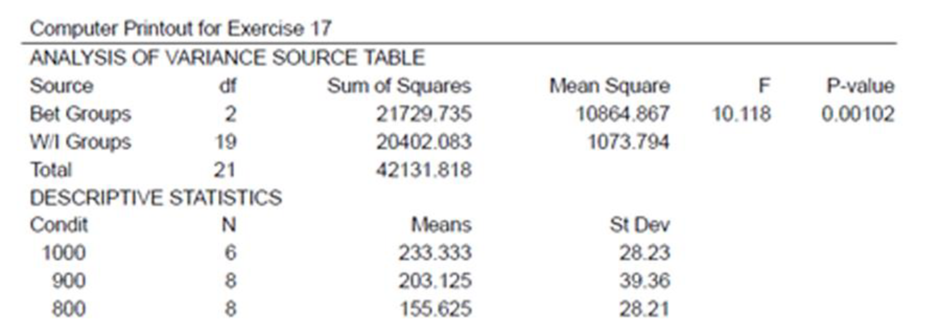
Concept explainers
For Exercises 7 through 20, assume that all variables are
a. State the hypotheses and identify the claim.
b. Find the critical value.
c. Compute the test value.
d. Make the decision.
e. Summarize the results, and explain where the differences in the
Use the traditional method of hypothesis testing unless otherwise specified.
17. Microwave Oven Prices A research organization tested microwave ovens. At a = 0.10, is there a significant difference in the average prices of the three types of oven?
| Waits | ||
| 1000 | 900 | 800 |
| 270 | 240 | 180 |
| 245 | 135 | 155 |
| 190 | 160 | 200 |
| 215 | 230 | 120 |
| 250 | 250 | 140 |
| 230 | 200 | 180 |
| 200 | 140 | |
| 210 | 130 | |
A computer printout for this exercise is shown. Use the P-value method and the information in this printout to test the claim. (The information in this exercise will be used in Exercise 6 of Section 12-2.)

Want to see the full answer?
Check out a sample textbook solution
Chapter 12 Solutions
ELEMENTARY STATISTICS: STEP BY STEP- ALE
- A company found that the daily sales revenue of its flagship product follows a normal distribution with a mean of $4500 and a standard deviation of $450. The company defines a "high-sales day" that is, any day with sales exceeding $4800. please provide a step by step on how to get the answers in excel Q: What percentage of days can the company expect to have "high-sales days" or sales greater than $4800? Q: What is the sales revenue threshold for the bottom 10% of days? (please note that 10% refers to the probability/area under bell curve towards the lower tail of bell curve) Provide answers in the yellow cellsarrow_forwardFind the critical value for a left-tailed test using the F distribution with a 0.025, degrees of freedom in the numerator=12, and degrees of freedom in the denominator = 50. A portion of the table of critical values of the F-distribution is provided. Click the icon to view the partial table of critical values of the F-distribution. What is the critical value? (Round to two decimal places as needed.)arrow_forwardA retail store manager claims that the average daily sales of the store are $1,500. You aim to test whether the actual average daily sales differ significantly from this claimed value. You can provide your answer by inserting a text box and the answer must include: Null hypothesis, Alternative hypothesis, Show answer (output table/summary table), and Conclusion based on the P value. Showing the calculation is a must. If calculation is missing,so please provide a step by step on the answers Numerical answers in the yellow cellsarrow_forward
 Glencoe Algebra 1, Student Edition, 9780079039897...AlgebraISBN:9780079039897Author:CarterPublisher:McGraw Hill
Glencoe Algebra 1, Student Edition, 9780079039897...AlgebraISBN:9780079039897Author:CarterPublisher:McGraw Hill Big Ideas Math A Bridge To Success Algebra 1: Stu...AlgebraISBN:9781680331141Author:HOUGHTON MIFFLIN HARCOURTPublisher:Houghton Mifflin Harcourt
Big Ideas Math A Bridge To Success Algebra 1: Stu...AlgebraISBN:9781680331141Author:HOUGHTON MIFFLIN HARCOURTPublisher:Houghton Mifflin Harcourt

